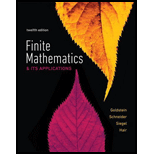
Concept explainers
Automobiles An experiment consists of selecting a car at random from a college parking lot and observing the color and make. Let E be the event “the car is red,” F be the event “the car is a Chevrolet,” G be the event “the car is a green Ford,” and H be the event “the car is black or a Chrysler.”
a. Which of the following pairs of events are mutually exclusive?
(i)E and F
(ii)E and G
(iii)F and G
(iv)E and H
(v)F and H
(vi)G and H
(vii)E′' and G
(viii)F′' and H′'
b. Describe each of the following events:
(i)
(ii)
(iii)E′'
(iv)F′'
(v)G′'
(vi)H′'
(vii)
(viii)
(ix)
(x)
(xi)
(xii)
(xiii)
Trending nowThis is a popular solution!

Chapter 6 Solutions
Finite Mathematics & Its Applications (12th Edition)
Additional Math Textbook Solutions
Basic College Mathematics
Thinking Mathematically (7th Edition)
Calculus for Business, Economics, Life Sciences, and Social Sciences (14th Edition)
Finite Mathematics for Business, Economics, Life Sciences and Social Sciences
Excursions in Modern Mathematics (9th Edition)
- a What is meant by the conditional probability of E given F? How is this probability calculated? b What are independent events? c If E and F are independent events, what is the probability of E and F occurring? What if E and F are not independent? d A jar contains 3 white and 7 black balls. Let E be the event the first ball drawn is black and let F be the event the second ball drawn is black. i Find P(EF) if the balls are drawn with replacement. ii Find P(EF) if the balls are drawn without replacement.arrow_forwardSpinner A and B shown in the figure are spun at the same time. (a) Are the events "spinner A stops on red” and “spinner B stops on yellow” independent? (b) Find the probability that spinner A stop on red and spinner B stops on yellow.arrow_forwardRoulette American roulette is a game in which a wheel turns on a spindle and is divided into 38 pockets. Thirty-six of the pockets are numbered 1-36, of which half are red and half are black. Two of the pockets are green and are numbered 0 and 00 (see figure). The dealer spins the wheel and a small ball in opposite directions. As the ball slows to a stop, it has an equal probability of landing in any of the numbered pockets. (a) Find the probability of landing in the number 00 pocket. (b) Find the probability of landing in a red pocket. (c) Find the probability of landing in a green pocket or a black pocket. (d) Find the probability of landing in the number 14 pocket on two consecutive spins. (e) Find the probability of landing in a red pocket on three consecutive spins.arrow_forward
 College AlgebraAlgebraISBN:9781305115545Author:James Stewart, Lothar Redlin, Saleem WatsonPublisher:Cengage Learning
College AlgebraAlgebraISBN:9781305115545Author:James Stewart, Lothar Redlin, Saleem WatsonPublisher:Cengage Learning Algebra and Trigonometry (MindTap Course List)AlgebraISBN:9781305071742Author:James Stewart, Lothar Redlin, Saleem WatsonPublisher:Cengage Learning
Algebra and Trigonometry (MindTap Course List)AlgebraISBN:9781305071742Author:James Stewart, Lothar Redlin, Saleem WatsonPublisher:Cengage Learning
 Holt Mcdougal Larson Pre-algebra: Student Edition...AlgebraISBN:9780547587776Author:HOLT MCDOUGALPublisher:HOLT MCDOUGALAlgebra & Trigonometry with Analytic GeometryAlgebraISBN:9781133382119Author:SwokowskiPublisher:Cengage
Holt Mcdougal Larson Pre-algebra: Student Edition...AlgebraISBN:9780547587776Author:HOLT MCDOUGALPublisher:HOLT MCDOUGALAlgebra & Trigonometry with Analytic GeometryAlgebraISBN:9781133382119Author:SwokowskiPublisher:Cengage College Algebra (MindTap Course List)AlgebraISBN:9781305652231Author:R. David Gustafson, Jeff HughesPublisher:Cengage Learning
College Algebra (MindTap Course List)AlgebraISBN:9781305652231Author:R. David Gustafson, Jeff HughesPublisher:Cengage Learning





